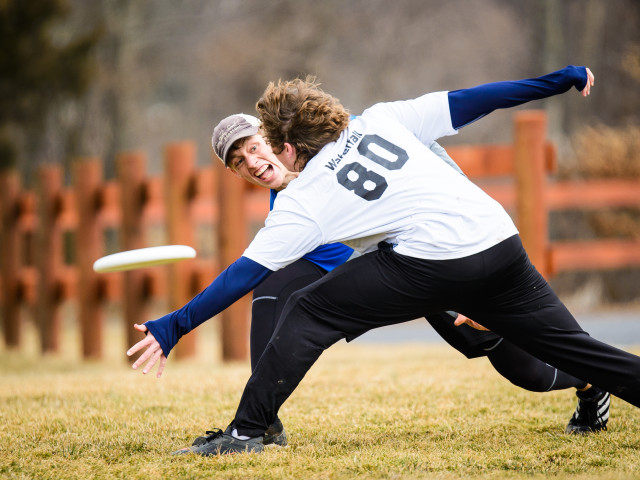 Undine Vektere (Latvia U19 Women) throws past Giulia Ricci (Italy U19 Women) in pool play of the 2014 World Junior Ultimate Championships. Photo by Brandon Wu, UltiPhotos.
Undine Vektere (Latvia U19 Women) throws past Giulia Ricci (Italy U19 Women) in pool play of the 2014 World Junior Ultimate Championships. Photo by Brandon Wu, UltiPhotos.
This interview appears in Skyd Magazine Vol. 1, Issue 1 – now available on Amazon.
Proactive and reactive. “Active” is about all these two have in common.
When people discuss sports, I often hear them talk about a player’s great reaction time. It’s an important part of playing, often on defense. Picture it: a player is guarding their opponent, sees the disc go up, and lunges out into the lane to smack it down. Reaction time in action.
But is that really reaction? Or did that defender set up in a proactive position to optimize their chance of getting that D?
I believe it’s the latter, and that proactive defense is what really earns victories. As, I’m in the camp that defense wins games. I love seeing Ds. But as I’ve matured, I’ve stopped thinking that generating them is about reacting and putting numbers on a stat sheet. Defense is about the steps that lead up to the block.
Let’s look at examples of how players might be either proactive or reactive when marking or guarding a downfield cutter.
Reactive Mark
On the mark, a marker is positioned a disc-width from the thrower. The marker’s movements are based on watching the throwers eyes along with their body movement. If a marker’s reaction time is quick enough, they might be able to put a hand in the right spot and get a hand block. Players that are reacting to a thrower usually chop their arms, and while I’ve never been able to clock it, said chopping arms are never as fast as an experienced thrower’s release. If anything, the attempted chop block results in a foul, as the movement comes too late and hits the thrower’s hand rather than a flying disc.
Proactive Mark
A proactive mark sets up a little off the thrower. They know the thrower has a variety of release options and that cutters can pretty easily change their cutting angles to get open for break throws. By stepping back, the marker increases the area they can prevent the thrower from throwing to. And again, while I don’t have clocked times, I’ll bet we can agree that with this kind of proactive positioning, the marker can more easily react to the thrower.
In evaluating both marking scenarios, consider the thrower’s ability to throw around a mark. A closer, more reactive mark will give the thrower easier angles. The proactive mark is disruptive. The thrower has less opportunity to step around because the marker is occupying the space ahead of the pivot. The thrower has to adjust, likely altering the type of throw they can make. Proactive marking is disruptive marking.
Reactive Cutter Defense
Moving downfield, consider a defender guarding a cutter. A simplistic, reactive defender will occupy space next to the offensive player according to the force. When that offensive player begins moving, the defender will react accordingly, and depending on the speed ratio of the two players, the defender may or may not keep up with the cut the offensive player is making. That defender will surely follow the cutter in the hopes that if a pass goes up to that player, they can try and make up some ground and contest the pass.
Add to that a defender who avoids any contact with the cutter. Instead of proactively occupying the desired cutting lane, the defender “opens the door,” allowing the cutter to pass through the opening to make the optimal cut. The next best thing that reactive defender will be able to do is set up a mark after the offense completes a simple pass.
Proactive Cutter Defense
Now consider a defender taking three things into account: the force, the position of the disc, and the offensive player is in relation to the disc. Being proactive is about taking all this into account and positioning accordingly. As the cutter begins moving, a proactive defender continues to reposition proactively, not allowing the cutter an easy path to the lane they want to take. By playing proactively, the defense disrupts the cutter, which throws off the offense’s timing.
Being proactive and reactive aren’t mutually exclusive. Reaction will always be a part of the game. But as the quality of your opponent rises, relying on reaction gets riskier because it’s harder to anticipate what a talented, experienced player is going to do. Being proactive is about being in the right place regardless of the particular offense or player you’re up against.










Comments Policy: At Skyd, we value all legitimate contributions to the discussion of ultimate. However, please ensure your input is respectful. Hateful, slanderous, or disrespectful comments will be deleted. For grammatical, factual, and typographic errors, instead of leaving a comment, please e-mail our editors directly at editors [at] skydmagazine.com.